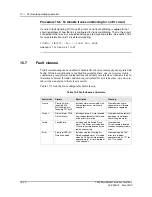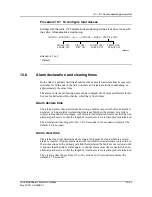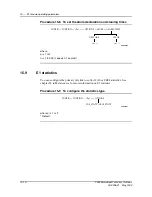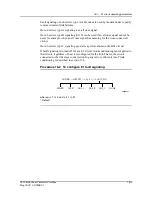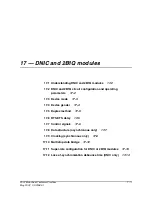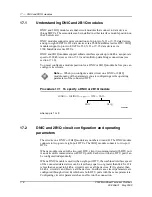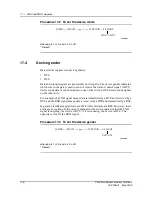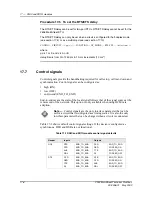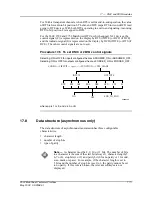
15 — E1 module operating parameters
15-10
2902 MainStreet Technical Practices
90-2906-01 May
2002
Unlike two-way trunk conditioning, if the fault signaling is seized, a seized signaling
code is transmitted without an idle signaling code first being outputted for a fixed
period of time. If the connected circuit is not a primary rate circuit, the node
continues to transmit the signaling being outputted.
If the connected circuit is not a primary rate circuit, the system transmits all zeros on
its information path; if it is a primary rate circuit, it transmits all ones.
Figure 15-3 One-way trunk conditioning (Group 1)
Group 2 one-way trunk conditioning
Figure 15-4 shows Group 2 one-way trunk conditioning. For Multiframe and
Incoming TS16 AIS alarms, one-way trunk conditioning breaks only the signaling
path in the direction of the fault. The information path is maintained in both
directions.
If the connected circuit is a primary rate circuit, the system transmits seized or idle
fault signaling (depending on the fault signaling selected for the connected circuit).
Unlike two-way trunk conditioning, if the fault signaling is seized, the seized
signaling code is transmitted without the idle signaling code first being outputted for
a fixed period of time. If the connected circuit is not a primary rate circuit, the system
continues to transmit the signaling being outputted.
8843
Information path
Signaling path
Primary rate
circuit
2902
MainStreet
Connected
circuit
Signaling path
Information path
Fault
Direction
of transmission
Direction
of transmission
Fault
Frozen
If primary
rate circuit
SEIZED
or
IDLE
If not primary
rate circuit
Signaling
All 1s
(primary rate circuit)
All 0s
(not primary rate circuit)
Information
Summary of Contents for MainStreet 2902
Page 1: ...2902 MainStreet Network Termination Unit Release 1 0 H T E C H N I C A L P R A C T I C E S ...
Page 40: ...3 Mounting the unit 3 8 2902 MainStreet Technical Practices 90 2906 01 May 2002 ...
Page 50: ...4 Ground and power connections 4 10 2902 MainStreet Technical Practices 90 2906 01 May 2002 ...
Page 68: ...6 Connecting to the network 6 4 2902 MainStreet Technical Practices 90 2906 01 May 2002 ...
Page 90: ...7 Connecting to data devices 7 22 2902 MainStreet Technical Practices 90 2906 01 May 2002 ...
Page 108: ...10 Node management 10 10 2902 MainStreet Technical Practices 90 2906 01 May 2002 ...
Page 150: ...14 CPSS 14 6 2902 MainStreet Technical Practices 90 2906 01 May 2002 ...
Page 218: ...20 Codirectional DCM 20 6 2902 MainStreet Technical Practices 90 2906 01 May 2002 ...
Page 234: ...22 HCM rate adaption 22 10 2902 MainStreet Technical Practices 90 2906 01 May 2002 ...
Page 246: ...23 Cross connecting circuits 23 12 2902 MainStreet Technical Practices 90 2906 01 May 2002 ...
Page 254: ...24 Visual indicators 24 8 2902 MainStreet Technical Practices 90 2906 01 May 2002 ...
Page 266: ...25 Alarms 25 12 2902 MainStreet Technical Practices 90 2906 01 May 2002 ...
Page 278: ...26 System diagnostics 26 12 2902 MainStreet Technical Practices 90 2906 01 May 2002 ...
Page 298: ...27 Loopbacks 27 20 2902 MainStreet Technical Practices 90 2906 01 May 2002 ...
Page 332: ...Glossary GL 8 2902 MainStreet Technical Practices 90 2906 01 May 2002 ...
Page 343: ......
Page 344: ... 2002 Alcatel All rights reserved 90 2906 01 95 1820 01 00 C ...

















